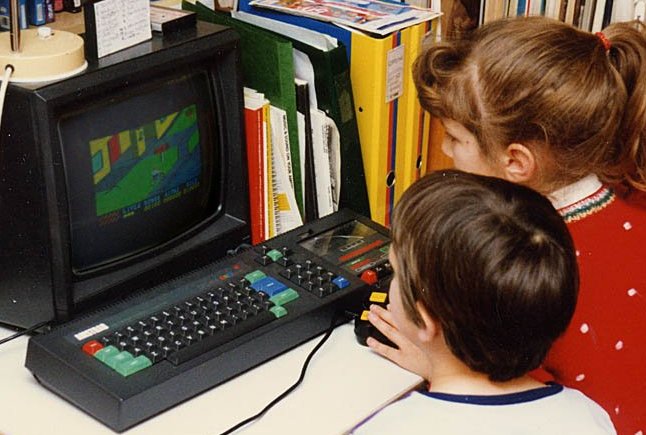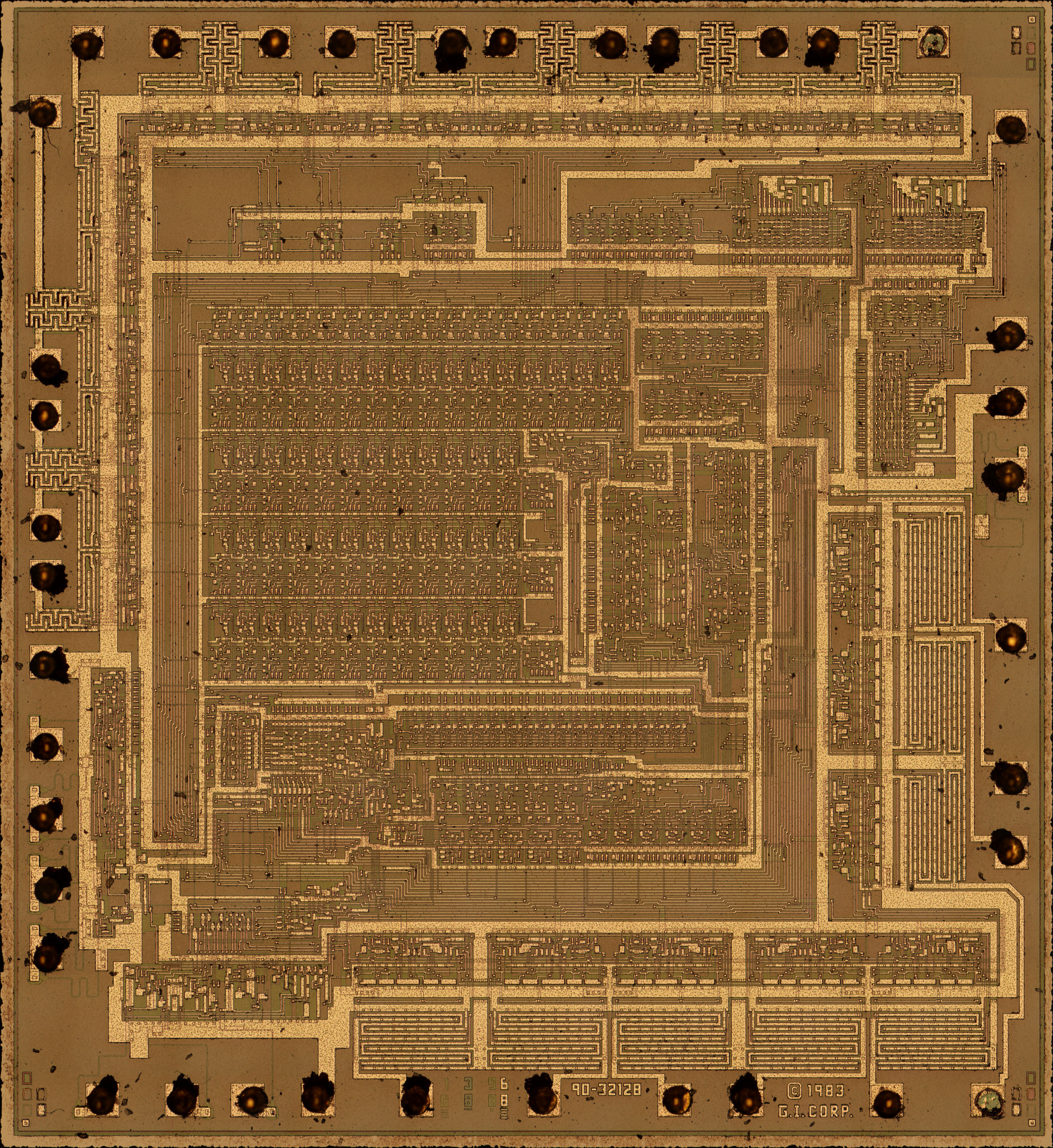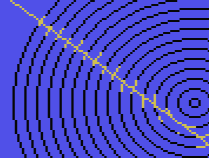|
ZX Spectrum Next
The ZX Spectrum Next is an 8-bit home computer, initially released in 2017, which is compatible with software and hardware for the 1982 ZX Spectrum. It also has enhanced capabilities. It is intended to appeal to retrocomputing enthusiasts and to "encourage a new generation of bedroom coders", according to project member Jim Bagley. Despite the name, the machine is not directly affiliated with Sinclair Research Ltd., Sir Clive Sinclair or the current owner of the trademarks, Sky Group. History The Next started life in 2010 in Brazil, as a variant of the TK95 Spectrum clone. In 2016, Victor Trucco and Fabio Belavenuto announced the "TBBlue" firmware, named after the two creators and the colour of the solder mask of the motherboard, a bare circuit board implementation of the product for advanced hobbyists. With the help of Henrique Olifiers the duo wanted to export the TBBlue to the UK, the ZX Spectrum's original home, having received moderate success with the board in Brazi ... [...More Info...] [...Related Items...] OR: [Wikipedia] [Google] [Baidu] |
Home Computer
Home computers were a class of microcomputers that entered the market in 1977 and became common during the 1980s. They were marketed to consumers as affordable and accessible computers that, for the first time, were intended for the use of a single, non-technical user. These computers were a distinct market segment that typically cost much less than business, scientific, or engineering-oriented computers of the time, such as those running CP/M or the IBM PC, and were generally less powerful in terms of computer memory, memory and expandability. However, a home computer often had better video display controller, graphics and sound than contemporary business computers. Their most common uses were word processing, playing video games, and computer programming, programming. Home computers were usually sold already manufactured in stylish metal or plastic enclosures. However, some home computers also came as commercial electronic kits, like the ZX80, Sinclair ZX80, which were both h ... [...More Info...] [...Related Items...] OR: [Wikipedia] [Google] [Baidu] |
Kickstarter
Kickstarter, PBC is an American Benefit corporation, public benefit corporation based in Brooklyn, New York City, that maintains a global crowdfunding platform focused on creativity. The company's stated mission is to "help bring creative projects to life". As of April 2025, Kickstarter has received US$8.71 billion in pledges from 24.1 million backers to fund 277,302 projects, such as films, music, stage shows, comics, journalism, video games, board games, technology, publishing, and food-related projects. People who back Kickstarter projects are offered tangible rewards or experiences in exchange for their pledges. This model traces its roots to subscription model of arts patronage, in which artists would go directly to their audiences to fund their work. History Kickstarter launched on April 28, 2009, by Perry Chen, Yancey Strickler, and Charles Adler. ''The New York Times'' called Kickstarter "the people's National Endowment for the Arts, NEA". ''Time (magazine), Time'' named ... [...More Info...] [...Related Items...] OR: [Wikipedia] [Google] [Baidu] |
SD-card
Secure Digital (SD) is a proprietary, non-volatile, flash memory card format developed by the SD Association (SDA). Owing to their compact size, SD cards have been widely adopted in a variety of portable consumer electronics, including digital cameras, camcorders, video game consoles, mobile phones, action cameras, and camera drones. The SD format was introduced in August 1999 by SanDisk, Panasonic (then known as Matsushita), and Kioxia (then part of Toshiba). It was designed as a successor to the MultiMediaCard (MMC) format, introducing several improvements aimed at enhancing usability, durability, and performance, which contributed to its rapid emergence as an industry standard. To manage the licensing and intellectual property rights related to the format, the three companies established SD-3C, LLC. In January 2000, they also founded the SDA, a non-profit organization dedicated to developing and promoting SD card standards. As of 2023, the SDA includes approximately 1,00 ... [...More Info...] [...Related Items...] OR: [Wikipedia] [Google] [Baidu] |
DV-MMC
MultiMediaCard, officially abbreviated as MMC, is a memory card standard used for solid-state storage. Unveiled in 1997 by SanDisk and Siemens, MMC is based on a surface-contact low-pin-count serial interface using a single memory stack substrate assembly, and is therefore much smaller than earlier systems based on high-pin-count parallel interfaces using traditional surface-mount assembly such as CompactFlash. Both products were initially introduced using SanDisk NOR-based flash technology. MMC is about the size of a postage stamp: 32 mm × 24 mm × 1.4 mm. MMC originally used a 1-bit serial interface, but newer versions of the specification allow transfers of 4 or 8 bits at a time. MMC can be used in many devices that can use Secure Digital (SD) cards. MMCs may be available in sizes up to 16 gigabytes (GB). They are used in almost every context in which memory cards are used, like cellular phones, digital audio players, digital cameras, and PDAs. ... [...More Info...] [...Related Items...] OR: [Wikipedia] [Google] [Baidu] |
VGA
Video Graphics Array (VGA) is a video display controller and accompanying de facto graphics standard, first introduced with the IBM PS/2 line of computers in 1987, which became ubiquitous in the IBM PC compatible industry within three years. The term can now refer to the computer display standard, the 15-pin D-subminiature VGA connector, or the resolution characteristic of the VGA hardware. VGA was the last IBM graphics standard to which the majority of IBM PC compatible computer manufacturers conformed, making it the lowest common denominator that virtually all post-1990 PC graphics hardware can be expected to implement. VGA was adapted into many extended forms by third parties, collectively known as Super VGA, then gave way to custom graphics processing units which, in addition to their proprietary interfaces and capabilities, continue to implement common VGA graphics modes and interfaces to the present day. The VGA analog interface standard has been extended to support r ... [...More Info...] [...Related Items...] OR: [Wikipedia] [Google] [Baidu] |
Digital-to-analog Converter
In electronics, a digital-to-analog converter (DAC, D/A, D2A, or D-to-A) is a system that converts a digital signal into an analog signal. An analog-to-digital converter (ADC) performs the reverse function. DACs are commonly used in music players to convert digital data streams into analog audio signals. They are also used in televisions and mobile phones to convert digital video data into analog video signals. These two applications use DACs at opposite ends of the frequency/resolution trade-off. The audio DAC is a low-frequency, high-resolution type while the video DAC is a high-frequency low- to medium-resolution type. There are several DAC architectures; the suitability of a DAC for a particular application is determined by figures of merit including: resolution, maximum sampling frequency and others. Digital-to-analog conversion can degrade a signal, so a DAC should be specified that has insignificant errors in terms of the application. Due to the complexity ... [...More Info...] [...Related Items...] OR: [Wikipedia] [Google] [Baidu] |
General Instrument AY-3-8910
The AY-3-8910 is a 3-voice programmable sound generator (PSG) designed by General Instrument (GI) in 1978, initially for use with their 16-bit computing, 16-bit General Instrument CP1600, CP1610 or one of the PIC microcontrollers, PIC1650 series of 8-bit computing, 8-bit microcomputers. The AY-3-8910 and its variants were used in many arcade games—Konami's ''Gyruss'' contains five—and Bally pinball machines as well as being the sound chip in the Intellivision and Vectrex video game consoles, and the Amstrad CPC, Oric-1, Colour Genie, Elektor TV Games Computer, MSX, Tiki 100 and later ZX Spectrum home computers. It was also used in the Mockingboard and Cricket sound cards for the Apple II and the Speech/Sound Cartridge for the TRS-80 Color Computer. After GI's spinoff of Microchip Technology in 1987, the chip was sold for a few years under the Microchip brand. It was also manufactured under license by Yamaha Corporation, Yamaha (with a selectable clock divider pin a ... [...More Info...] [...Related Items...] OR: [Wikipedia] [Google] [Baidu] |
Sprite (computer Graphics)
In computer graphics, a sprite is a Plane (mathematics), two-dimensional bitmap that is integrated into a larger scene, most often in a 2D video game. Originally, the term ''sprite'' referred to fixed-sized objects composited together, by hardware, with a background. Use of the term has since become more general. Systems with hardware sprites include arcade video games of the 1970s and 1980s; game consoles including as the Atari VCS (1977), ColecoVision (1982), Nintendo Entertainment System, Famicom (1983), Sega Genesis, Genesis/Mega Drive (1988); and home computers such as the TI-99/4 (1979), Atari 8-bit computers (1979), Commodore 64 (1982), MSX (1983), Amiga (1985), and X68000 (1987). Hardware varies in the number of sprites supported, the size and colors of each sprite, and special effects such as scaling or reporting pixel-precise overlap. Hardware composition of sprites occurs as each scan line is prepared for the video output device, such as a cathode-ray tube, without i ... [...More Info...] [...Related Items...] OR: [Wikipedia] [Google] [Baidu] |
Colour Clash
Attribute clash (also known as colour clash or bleeding) is a display artifact caused by limits in the graphics circuitry of some colour 8-bit home computers, most notably the ZX Spectrum, where it meant that only two colours could be used in any 8×8 tile of pixels. The effect was also noticeable on MSX software and in some Commodore 64 titles. Workarounds to prevent this limit from becoming apparent have since been considered an element of Spectrum programmer culture. This problem also happens with the "semigraphic modes" (text modes with graphics features) of the Color Computer and Dragon, but those computers also have non-attributed graphics and with better resolution. Several video game consoles of the era had such video modes that caused such limitations, but usually allowed more than two colours per tile: the NES (Famicom) had only one mode, which was also "semigraphic", and allowed four colours per 16×16 "block" (group of four 8×8 tile) but 16 per screen. The Super N ... [...More Info...] [...Related Items...] OR: [Wikipedia] [Google] [Baidu] |
Motherboard
A motherboard, also called a mainboard, a system board, a logic board, and informally a mobo (see #Nomenclature, "Nomenclature" section), is the main printed circuit board (PCB) in general-purpose computers and other expandable systems. It holds and allows communication between many of the crucial electronic components of a system, such as the central processing unit (CPU) and computer memory, memory, and provides connectors for other peripherals. Unlike a backplane, a motherboard usually contains significant sub-systems, such as the CPU, the chipset's input/output and Memory controller, memory controllers, interface (computing), interface connectors, and other components integrated for general use. Nomenclature ''Oxford English Dictionary'' traces the origin of the word ''motherboard'' to 1965, its earliest-found attestation occurring in the magazine ''Electronics (magazine), Electronics''. The term alludes to its importance and size compared to the components attached to i ... [...More Info...] [...Related Items...] OR: [Wikipedia] [Google] [Baidu] |
Retro Gamer
''Retro Gamer'' is a British magazine, published worldwide, covering Retrogaming, retro video games. It was the first commercial magazine to be devoted entirely to the subject. Launched in January 2004 as a quarterly publication, ''Retro Gamer'' soon became a monthly. In 2005, a general decline in gaming and computer magazine readership led to the closure of its publishers, Live Publishing, and the rights to the magazine were later purchased by Imagine Publishing. It was taken over by Future plc on 21 October 2016, following Future's acquisition of Imagine Publishing. History The first 18 issues of the magazine came with a coverdisk. It usually contained freeware remakes of retro video games and emulators, but also videos and free commercial PC software such as ''The Games Factory'' and ''The Elder Scrolls: Arena''. Some issues had themed CDs containing the entire back catalogue of a publisher, such as Durell Software, Durell, Llamasoft and Gremlin Graphics. On 27 September 2005, ... [...More Info...] [...Related Items...] OR: [Wikipedia] [Google] [Baidu] |
PC Pro
''PC Pro'' is one of several computer magazines published monthly in the United Kingdom by Future plc. Its headquarters is in London. ''PC Pro'' also licenses individual articles (or even the whole magazine) for republication in various countries around the world - and some articles are translated into local languages. , it claimed to be the biggest-selling monthly PC magazine in the UK. ''PC Pro'' is promoted as a magazine for "IT professionals, IT managers and power users." It is a fairly 'rounded' magazine as it contains information on many different aspects of IT (such as cheap hardware, extreme hardware, software, business, home, retailers) rather than just one of these areas like many UK PC magazines. While it is primarily Windows-focused, it does contain some open source and Apple content. The magazine was launched in November 1994. The website was launched in December 1996. On 3 June 2015 Dennis Publishing relaunched the PC Pro website as Alphr. The magazine continue ... [...More Info...] [...Related Items...] OR: [Wikipedia] [Google] [Baidu] |








